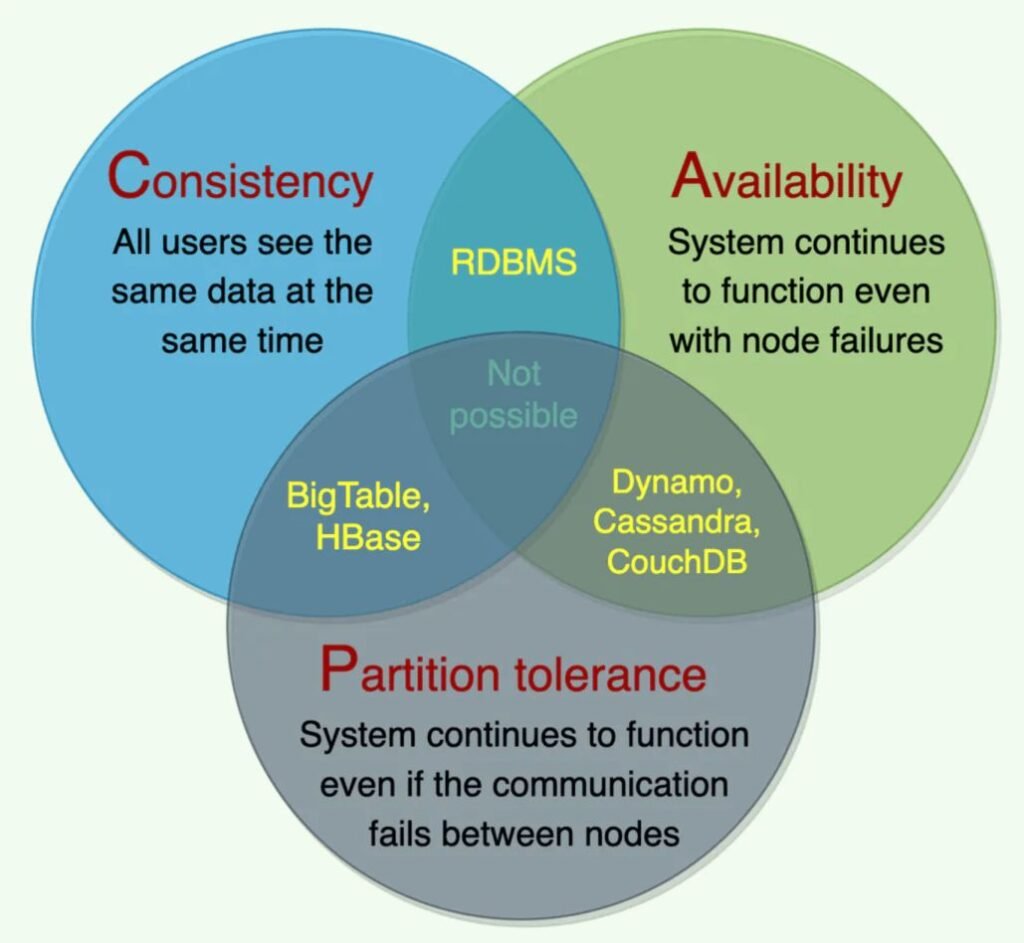Components of CAP Theorem
In this tutorial, we are going to discuss about the Components of CAP Theorem in system design. The CAP theorem revolves around three key properties of distributed systems: Consistency, Availability, and Partition Tolerance. Each of these properties plays a vital role in determining the behavior of a distributed system under various conditions.

Now lets go through the Components of CAP Theorem.
Consistency
Consistency in distributed systems refers to the degree to which the system maintains a single, up-to-date version of the data. There are different levels of consistency, depending on the requirements of the system.
- Strong consistency: In a strongly consistent system, all nodes see the same data at the same time. Any read operation returns the most recent write operation’s result, ensuring that the system maintains a single, coherent version of the data. Strong consistency is desirable for applications that require accurate and up-to-date information at all times, such as financial transactions or inventory management systems.
- Eventual consistency: In an eventually consistent system, nodes may temporarily have different versions of the data, but they will eventually converge to the same, consistent state. Eventual consistency is suitable for applications where slight inconsistencies can be tolerated for short periods, such as social media updates or user profiles. This model offers better availability and performance compared to strong consistency, at the cost of temporary data inconsistencies.
In summary, consistency in the CAP theorem represents the guarantee that the data viewed by clients is always up-to-date and consistent across all nodes in the distributed system.
Availability
Availability refers to the ability of a distributed system to continue operating and responding to requests despite failures or partial outages. Highly available systems ensure that every request receives a response, either a success or an error, without significant delays.
- High availability: High availability is achieved by replicating data across multiple nodes and designing the system to handle failures gracefully. In a highly available system, the loss of individual nodes does not cause a significant impact on the overall operation, as other nodes can continue to serve requests.
Availability ensures that clients can continue to interact with the system and perform operations, even if certain nodes in the system are experiencing issues. This is particularly important in distributed systems where failures are common due to the inherent complexities of network communication and the potential for hardware or software failures.
Achieving availability often involves replication and redundancy strategies, where data is duplicated across multiple nodes in the system. If one node becomes unavailable, clients can still access the data from other available nodes. Additionally, mechanisms such as load balancing and failover systems can help distribute client requests evenly across available nodes and redirect traffic away from failed or overloaded nodes.
In summary, availability in the CAP theorem represents the ability of a distributed system to remain operational and responsive to client requests, even in the presence of failures or network partitions.
Partition Tolerance
In the CAP theorem, partition tolerance refers to the system’s ability to continue operating and functioning correctly despite arbitrary message loss or network partitions. Network partitions occur when communication between nodes in a distributed system is disrupted, leading to some nodes being unable to communicate with others.
Partition tolerance is a critical aspect of distributed systems, particularly in large-scale deployments where network failures are common due to factors such as network congestion, hardware failures, or geographical distance between nodes.
Ensuring partition tolerance means that the system can handle situations where nodes become isolated from each other due to network issues, and it can continue to serve client requests and maintain consistency and availability despite these partitions.
- Network partitioning: In a distributed system, nodes communicate with each other over a network. Network partitions occur when communication between some or all nodes is interrupted or lost. This can be caused by various reasons, such as hardware failures, network congestion, or configuration issues.
- Handling partition failures: Partition-tolerant systems are designed to handle network partitions gracefully and continue to operate without compromising their guarantees. This often involves strategies such as data replication, fallback mechanisms, and automatic recovery processes. However, as the CAP theorem states, it is impossible to guarantee consistency, availability, and partition tolerance simultaneously, so system designers must make trade-offs based on the specific requirements of their application.
Achieving partition tolerance often involves strategies such as replication, where data is stored across multiple nodes in the system, and mechanisms for detecting and resolving network partitions, such as distributed consensus algorithms like Paxos or Raft.
However, achieving partition tolerance may require sacrificing either consistency or availability in certain situations, as ensuring that the system can tolerate partitions often involves trade-offs with other aspects of system behavior.
In summary, partition tolerance in the CAP theorem represents the system’s ability to continue operating and providing services even when communication between nodes is disrupted or when nodes become temporarily unreachable due to network partitions.
Understanding these three components of the CAP theorem is crucial for designing distributed systems that strike a balance between consistency, availability, and partition tolerance based on the specific requirements and trade-offs of the application or use case.
That’s all about the Components of CAP Theorem in system design. If you have any queries or feedback, please write us email at contact@waytoeasylearn.com. Enjoy learning, Enjoy system design..!!